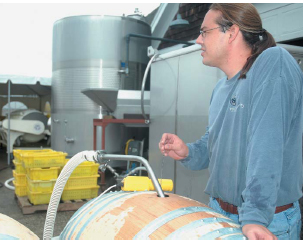
ISLAND terroir
Understanding Brooklyn’s Closest Wine Region
By lisa granik
“Shame on me” was Joe Pipia’s frank self-assessment, admitting he knew nothing about Long Island wines until very recently. Pipia, whose mother purchased what is now Vineyard 48 on the North Fork of Long Island, grew up in the city and summered in the Hamptons.But until a few years ago, he had never even tried a wine from Long Island. “I didn’t know they could be any good,” he confessed.
Pipia’s recent discovery of Long Island wines is not unusual.Though the region is 70 miles east of the borough, Brooklynites are only beginning to discover the wine country in our backyard. As a wine region, Long Island is young, without the generations of experience and tradition that distinguish Australia’s Barossa or France’s Bordeaux. In fact, although wild grapes have long grown throughout the eastern United States, it was only in 1973 that Alex and Louisa Hargrave planted Long Island’s first grapes of European origin, for making wine. Although 30 years is a blink of an eye in wine-growing terms, today the East End is home to over 35 wineries, and its reach is spreading beyond the Island. Park Slope’s Bruce Schneider, who owns Schneider Vineyards in Riverhead, proudly points to top restaurants in the tri-state area, Chicago, and San Francisco pouring his wines.
In a world full of wine, what distinguishes those from Long Island? Are they worth seeking out, whether at the corner wine store or on a weekend adventure in our very own wine country?First, a bit of context. In wine, as in other art forms, less is often more: it can be easy to make a big, fat, powerful wine, but it takes skill to produce a wine of finesse, elegance and delicacy. This might be Long Island’s best foot forward. “My wines are as natural as I can make them,” says Joe Macari of Macari Vineyards in Mattituck. “I don’t want to cover up the delicate fruit and spice flavors with a lot of wood. I want the complexity to reveal itself.”
California and Australia’s warm weather grows grapes that hold more sugar. With relative ease, winemakers there translate this ripe sweetness into big, fruity, fleshy wines. But because Long Island has a comparatively cool climate, its wines are naturally lighter bodied, with more refreshing crispness. “Our red wines show more red, not black, fruits,” says Chris Tracy of Channing Daughters Winery in Bridgehampton. “They breathe red currants, plums, cherries.”
True, Bordeaux’s temperate weather is like Long Island’s. But climate is only one of the factors that influences wine growing. The sandy loam soil on Long Island, for instance, offers good drainage for the vines, and imparts a different character to the wines than the gravelly soil in Bordeaux. East End vintners are just beginning to understand the relationships among their climate, soil, grape varieties, growing practices, and finished product.
Moreover, the small, artisanal wines of Long Island should not be compared to inexpensive wines from large production areas like Australia or California’s Central Valley, where fertile soils allow large volumes of wine to be produced from each vine. Due to the limited production scale, Long Island wines are better compared to other handcrafted wines from regions with difficult growing conditions, such as the Loire Valley, northern Italy, or Austria. But they need not be expensive. Plenty of expressive Long Island wines can be had for $15-20.
Long Island is young as a wine region, but as it evolves, two distinctive styles of red wine are emerging. The first is the more structured and serious, expressing “balance, elegance, finesse,” according to Russell Hearn of Cutchoguebased Pellegrini. “Anybody who knows anything about winemaking knows that these qualities are the hardest to achieve, much more difficult than weight and bigness.Besides, we’re not going to out-big any other wine region.”
Ten years ago, Long Island winemakers hadn’t yet learned this, and were trying to make the wines into something they just weren’t. “Pushing a wine somewhere it doesn’t want to go makes it awkward,” says Hearn. In the past 10 years East End winemakers have learned to let the fruit speak, rather than covering it up by aging too long in new oak barrels.
The second style is lighter bodied, maybe less ambitious, less pretentious. These are meant to be enjoyed, not studied. Channing Daughters’ Pinot Envy is a fresh, Beaujolais style brimming with red fruits. Schneider’s Le Breton is a crisp, light, cherry- and violet-scented wine made only from cabernet franc grapes.(Cabernet franc is known as “Le Breton” in the Loire Valley.) Whether these reds are crafted to drink now or to hold, they share a dark quality on the palate, reminiscent of smoke or tobacco that is part of the Long Island red flavor signature.
This tarry element adds an interesting complexity and personality, a bass note in counterpoint to the higher-toned, bright fruit flavors. It proves that Long Island wines are of interest not because they are local imitations of something else, but distinctive in their own right. “I don’t want to make California wine,” says Macari. “I believe in this region, I believe our wines have something different to say.”
Editor’s note: Long Island wines can be found in many wine shops throughout Brooklyn. Fermented Grapes in Prospect Heights, and Prospect Wine Shop and Red, White and Bubbly in Park Slope all have fine selections.McCabe’s Wine and Spirits and Vintage New York in Manhattan have the largest selections in the metropolitan area. For more information on Long Island wines, see liwines.com.



